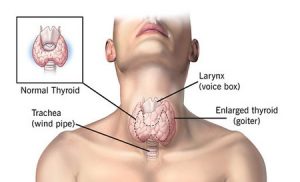What is a goiter? Types and methods of treating goiter
What is goiter, and how is it treated?
In medicine, an abnormal increase in the size of the thyroid gland is called goiter. The thyroid is a small butterfly gland located under the neck present in all healthy people and produces substances called hormones carried into the bloodstream. Although most goiters are painless, having a large goiter can cause coughing and even swallowing or breathing.

How many types of goiter are there?
Goiter is divided into four groups depending on the growth rate of the thyroid gland. These groups include:
- Grade goiter 1 or intangible goiter
- Class 2 goiter or flexible and invisible goiter
- Grade 3 goiter or visible and flexible goiter
- Goiter or grade 4 goiter is seen remotely
Hypothyroidism
An overactive or overactive thyroid gland can cause an enlarged thyroid gland or goiter. In hypothyroidism and Hashimoto’s autoimmune diseases, the pituitary gland is formed by the secretion of thyroid-stimulating hormone. The thyroid gland is stimulated, which causes the thyroid gland to enlarge.
Symptoms of goiter due to hypothyroidism:
Dry skin, shortness of breath, weight gain, depression, coarse hair, hair loss, constipation, increased heart rate.
overactive thyroid:
When a person’s thyroid gland is overactive, it is like when a patient has a serious problem. This leads to the production of thyroid-stimulating immunoglobulin, or TSI, which invades the thyroid gland after production and causes the thyroid gland to become overactive.
Under these conditions, the thyroid gland grows and ends in goiter. In this dimension of goiter, symptoms such as shortness of breath, weight loss, constipation, anger, increased sweating, tremors in the hands, thin and brittle hair, brittle nails.
Tied goiter sample:
In nodular goiter, there may be multiple glands on either side of the thyroid or one side. This pattern of goiter is often benign, but malignant goiter is associated with cancer and is seen in some people.

How much does the incidence of goiter increase?
Age: Goiter can affect different age groups, but most often occurs in people over 40.
Gender: Goiter is more common in women, so female patients are more than male patients. And it can be said that women are more prone to thyroid problems than men.
Iodine deficiency: One of the main causes of goiter is iodine deficiency, but today iodine deficiency occurs in fewer people.
Family history or hereditary goiter: Goiter is common in people with autoimmune disease or family history.
Immune-suppressing drugs: Increases the risk of goiter in a person if used continuously and for a long time.
Pregnancy and the end of menstruation: During most women’s lives, there are two important and sensitive periods: pregnancy and the end of menstruation or menopause. During these two essential periods, thyroid problems, including goiter, become more active for hormonal and medical reasons.
Paraclinical diagnostic test: Paraclinical is one of the diagnostic methods of some diseases. Several paraclinical procedures show that patients are exposed to radiation, which puts them at risk for goiter and thyroid disease.
Goiter examination methods:
Sampling: This operation is performed on an outpatient basis without the need for anesthesia or local anesthesia called FNA. This operation is safe and causes very little pain. If the patient is taking anticoagulants, it is necessary to consult a specialist. By sampling an enlarged thyroid gland, a thin needle is inserted into one of the thyroid nodes to inject several cells; then, the pathologist stains the samples so that he can examine them.
Of course, the goiter may be filled with fluid, in which case all or part of the fluid can be removed with a syringe. Statistically, 90 to 95% of cases of this biopsy show benign or malignant goiter of the patient.
Thyroid scan: A small amount of radioactive material is used to perform a thyroid scan. The thyroid gland absorbs these substances through the blood, and a special camera is used to take pictures of the thyroid gland during the scan.
The thyroid scan is safe, and the amount of radiation used in the scan is minimal and does not cause any problems for the patient. However, people such as pregnant or lactating women should not use a thyroid scan.
Other tests: A blood test is done to evaluate the function of the thyroid gland at the initial and necessary visits. However, a blood test may be used during treatment.

Herbal and home remedies that improve goiter:
Include iodine in your diet: As described, low iodine levels are one of the main causes of a goiter. To treat this disease, the diet contains the right amount of iodine, and for older age groups, the amount or dose of iodine is usually 150 micrograms per day.
It is recommended that patients with goiter eat foods high in iodine. Some of these foods include iodized salt, cabbage, seafood, fish, eggs, shrimp, turkey, natural yogurt, cow’s milk, beans, fries, blueberries.
Of course, goiter is not always due to iodine and sometimes due to increased iodine in the body. Therefore, if you have a goiter, you should consult a specialist about iodine intake.
Replacing Algae Powder with Salt: Catfish or seagulls are a large group of algae. This algae is a source of iodine and can effectively improve the function of the goiter and thyroid, and this substance is available in the market and in some cases. This alga has a salty taste, so that it can replace salt in some foods. Cabbage also contains potassium, calcium, magnesium, and iron.
The dry matter of these algae is used to treat goiter so that patients can add a maximum of 2 tablespoons of dry powder to their favorite food. Of course, in addition to powder, seaweed capsules are also produced by pharmaceutical companies.

Consumption of vegetables: Vegetables are rich in iodine, so that this natural treatment can prevent goiter surgery. Plants also contain minerals and nutrients such as sulfur, germanium, and antioxidants, which are usually beneficial to the thyroid gland and have beneficial effects. These vegetables can be used in two different ways. In the first method, you can chop a few leaves of this vegetable and after forming a paste, place it on the swollen area of the neck, in which case it is better to stay in the patient for 15 to 20 minutes and then wash it, and this treatment can be done at least It lasted for ten days.
In the second method of using vegetables, you have to mix a mixture of 2 tablespoons with half a glass of water. Then drink this mixture daily at three different time intervals for six weeks.


